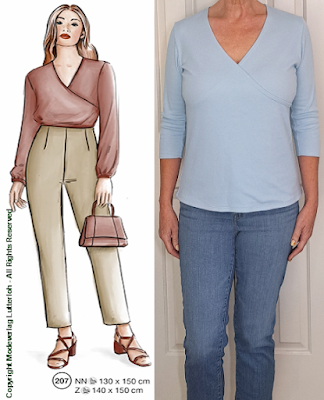Supplement 290 - Model #39 - 2013
Full Figure Panties Pattern
Hi there everyone and Happy New Year! I for one am glad the holidays are winding down. My sewing machines could use servicing and frankly I really don't need any specific items of clothing right now. In an attempt to pare down my fabric scraps I decided to make undies out of some of my favorite prints. These will just be for everyday wear under jeans or dresses or whatever.
Pattern Hints:
I looked through many Lutterloh patterns to decide on this one. There was another more recent one that looked promising but I chose this one for the slightly higher cut leg. There were even swimsuit bottoms that I considered but this one seemed to most closely resemble the shape I commonly wear. Make sure to look at the line drawings for the patterns to get a better idea of the expected fit.
Don't be surprised if you end up making a test pair or two. Since underwear fits so closely and each knit fabric has its own properties you may get a better fit with one fabric over another. The elastic will affect the fit as well so you may want to try more than one type to find what's comfortable.
Design Changes:
I did make a few minor changes to this pattern to make it fit my preference. First, since this is for full figures, I enlarged the pattern to a size that was a full 6 sizes lower than my measurement. My first attempt was downright baggy but that could have been a feature of my fabric choice too. Once the size was right I wanted to cut the legs a little higher. I drew the curve for the top of the leg opening a half inch higher than suggested and then added a half inch to the top hem all around the pattern. I didn't want the sides to end up like string bikinis. There was a little tweaking of the back leg shape too but the curves were pretty close from the start.
There is a suggestion for cutting a crotch lining for these undies and I would agree they need one. I actually cut my pattern apart at this marking to make a 2 piece front. It's marked on the pattern diagram that I included in the next section. In my opinion this made it easier to attach the lining and keep all the seam allowances tucked in and neat.
Fabric Used/Suggested:
These were all made from remnants of past projects but they are all cotton knits. The 2 way stretch knits fit better when I cut a smaller seam allowance but the elastic lengths worked the same for every pair. Once you get those figured out you can line up several pairs of panties to sew in a production line. If you're going to try more than one type of elastic (picot, clear, fold over etc.) it's probably best to do that in the initial "muslin" phase so you can see how each type affects the fit. I would keep all your fabric choices similar to each other so there are no surprises after applying the elastic.
The elastic I ended up using for most of my panties was 3/8" clear elastic for the legs and 5/8" picot elastic for the waistband. I was equally pleased with picot elastic on the legs and clear elastic on the waist but I was at least trying to match colors so they're an assortment of fabrics and finishes. My elastic measurements ended up about 3/4 of the length of the fabric they were gathered to. For example: If the waist of my panties measures 32 inches then I would use 24 inches of elastic. The same goes for the leg holes. Turn your measuring tape on its side to get an accurate measurement.
If you search there are plenty of sites on the internet that will explain the different applications for each type of elastic. What's a little harder to find is an explanation of how specifically to apply it to the legs of panties. I've included a diagram below to demonstrate where I applied my elastic at a 1:1 ratio and where I stretched the elastic to fit better on the buttocks. The pink line on the outside is where I sewed on my elastic with little to no stretching. The area of the panties that gets gathered the most is all in the back leg. You'll need to stretch your elastic quite a bit to attach all the fabric to the elastic in this area. The pink arrow is pointing to the edge of the lining where I cut my pattern to make a third piece as I mentioned in Design Changes above. After a little experimenting I found I preferred to serge the elastic to the inside of the fabric, turn and then topstitch down from the outside with a stretch stitch. Your preferred method may be different depending on your type of elastic.
Closing Hints:
For such a small project that seemed like a lot of explaining. I assure you, once you work out the shape and the elastic measurements, these really are a quick sew. I don't know that I would go to the trouble if I only needed one pair but when you make them assembly line style they come together in a snap. You also have the benefit of having a pattern to use in the future that can help use up those scraps you couldn't part with.
Here's to using up our stash and finishing those projects in the new year!
Until next time, happy sewing everyone,
Ann in Calif.


















